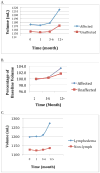Pre-operative assessment enables early diagnosis and recovery of shoulder function in patients with breast cancer
- PMID: 20054643
- PMCID: PMC2940708
- DOI: 10.1007/s10549-009-0710-9
Pre-operative assessment enables early diagnosis and recovery of shoulder function in patients with breast cancer
Abstract
In order to determine the extent and time course of upper limb impairment and dysfunction in women being treated for breast cancer (BC), and followed prospectively, a novel physical therapy surveillance model post-treatment was used. Subjects included adult women with newly diagnosed, untreated, unilateral, Stage I to III BC, and normal physiological and biomechanical shoulder function. Subjects were excluded if they had a previous history of BC, or prior injury or surgery of the affected upper limb. Measurements included body weight, shoulder ranges of motion (ROM), manual muscle tests, pain levels, upper limb volume, and an upper limb disability questionnaire (ULDQ). Measurements were taken at baseline (pre-surgery), and 1, 3-6, and 12 months post-surgery. All subjects received pre-operative education and exercise instruction and specific physical therapy (PT) protocol after surgery including ROM and strengthening exercises. All measures of function were significantly reduced 1 month post-surgery, but most recovered to baseline levels by 1-year post-surgery. Some subjects developed signs of lymphedema 3-12 months post-surgery, but this did not compromise function. Shoulder abduction, flexion, and external rotation, but not internal rotation ROM, were associated with the ULDQ. Most women in this cohort undergoing surgery for BC who receive PT intervention may expect a return to baseline ROM and strength by 3 months. Those who do not reach baseline, often continue to improve and reach their pre-operative levels by 1-year post-surgery. Lymphedema develops independently of shoulder function 3-12 months post-surgery, necessitating continued monitoring. A prospective physical therapy model of surveillance allows for detection of early and later onset of impairment following surgery for BC in this specific cohort of patients.
Figures
Similar articles
-
Long term effects of manual lymphatic drainage and active exercises on physical morbidities, lymphoscintigraphy parameters and lymphedema formation in patients operated due to breast cancer: A clinical trial.PLoS One. 2018 Jan 5;13(1):e0189176. doi: 10.1371/journal.pone.0189176. eCollection 2018. PLoS One. 2018. PMID: 29304140 Free PMC article. Clinical Trial.
-
The upper-limb volumetric changes in breast cancer survivors with axillary web syndrome.Eur J Cancer Care (Engl). 2017 Mar;26(2). doi: 10.1111/ecc.12637. Epub 2017 Feb 9. Eur J Cancer Care (Engl). 2017. PMID: 28181311
-
Exercise Protocol With Limited Shoulder Range of Motion for 15 or 30 Days After Conservative Surgery for Breast Cancer With Oncoplastic Technique: A Randomized Clinical Trial.Am J Clin Oncol. 2021 Jun 1;44(6):283-290. doi: 10.1097/COC.0000000000000811. Am J Clin Oncol. 2021. PMID: 33731646 Clinical Trial.
-
Effectiveness of early rehabilitation on range of motion, muscle strength and arm function after breast cancer surgery: a systematic review of randomized controlled trials.Clin Rehabil. 2019 Dec;33(12):1876-1886. doi: 10.1177/0269215519873026. Epub 2019 Sep 3. Clin Rehabil. 2019. PMID: 31480855
-
Effectiveness of therapeutic inflatable ball self-exercises for improving shoulder function and quality of life in breast cancer survivors after sentinel lymph node dissection.Support Care Cancer. 2019 Jul;27(7):2349-2360. doi: 10.1007/s00520-019-4656-0. Epub 2019 Mar 12. Support Care Cancer. 2019. PMID: 30874927 Review.
Cited by
-
Shared concern with current breast cancer rehabilitation services: a focus group study of survivors' and professionals' experiences and preferences for rehabilitation care delivery.BMJ Open. 2020 Jul 28;10(7):e037280. doi: 10.1136/bmjopen-2020-037280. BMJ Open. 2020. PMID: 32723743 Free PMC article.
-
Use of a prospective surveillance model to prevent breast cancer treatment-related lymphedema: a single-center experience.Breast Cancer Res Treat. 2016 Nov;160(2):269-276. doi: 10.1007/s10549-016-3993-7. Epub 2016 Sep 24. Breast Cancer Res Treat. 2016. PMID: 27665585 Free PMC article.
-
Machine learning for detection of lymphedema among breast cancer survivors.Mhealth. 2018 May 29;4:17. doi: 10.21037/mhealth.2018.04.02. eCollection 2018. Mhealth. 2018. PMID: 29963562 Free PMC article.
-
Cancer Rehabilitation Publications (2008-2018) With a Focus on Physical Function: A Scoping Review.Phys Ther. 2020 Mar 10;100(3):363-415. doi: 10.1093/ptj/pzz184. Phys Ther. 2020. PMID: 32043151 Free PMC article.
-
Clinician's Commentary on Singh et al.(1.).Physiother Can. 2013 Spring;65(2):192-3. doi: 10.3138/ptc.2012-23OCC. Physiother Can. 2013. PMID: 24403684 Free PMC article. No abstract available.
References
-
- Kuroi K, Shimozuma K, Taguchi T, et al. Evidence-based risk factors for seroma formation in breast surgery. Jpn J Clin Oncol. 2006;36:197–206. - PubMed
-
- Sugden EM, Rezvani M, Harrison JM, et al. Shoulder movement after the treatment of early stage breast cancer. Clin Oncol (R Coll Radiol) 1998;10:173–181. - PubMed
-
- Tasmuth T, von Smitten K, Hietanen P, et al. Pain and other symptoms after different treatment modalities of breast cancer. Ann Oncol. 1995;6:453–459. - PubMed
-
- Yap KP, McCready DR, Narod S, et al. Factors influencing arm and axillary symptoms after treatment for node negative breast carcinoma. Cancer. 2003;97:1369–1375. - PubMed
-
- Tengrup I, Nittby LT, Christiansson I, et al. Problems with arms are common after breast surgery. Lymphedema is a frequent complication in elderly women treated for breast cancer. Lakartidningen. 1999;96:5089–5091. - PubMed
Publication types
MeSH terms
Grants and funding
LinkOut - more resources
Full Text Sources
Medical





